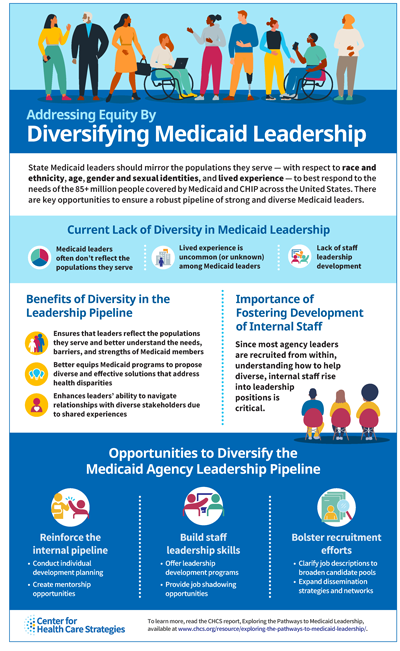Medicaid and CHIP serve over 85 million people across the U.S., including adults and children of every age who represent the broad diversity of our nation in terms of race and ethnicity, sexual orientation, and other socio-demographics. To best meet the health-related needs of such a diverse group of people — and better address equity within programs and services — Medicaid leaders should reflect the varied populations they serve.
When Medicaid leaders mirror the identities of enrollees, they may better relate to the needs, challenges, and strengths of their members. Sharing common perspectives with member populations can help leaders identify more effective strategies to address disparities — in particular, by providing insight into how policies and programs may impact communities differently. Lived and common experiences may also help Medicaid leaders better understand and navigate relationships with diverse stakeholders, including consumers and communities.
Medicaid agencies can diversify their leadership by hiring new staff or promoting from within. While recruiting from outside the agency offers specific opportunities — expanding hiring networks, for example — most Medicaid leaders rise up from within the agency. This provides a unique opportunity to foster the growth of internal diverse Medicaid staff because Medicaid agencies tend to have more diversity at entry/junior levels. This blog post and a related infographic highlight three key strategies for both internally and externally diversifying the Medicaid leadership pipeline, drawing from a report by the Center for Health Care Strategies (CHCS) developed with support from the Robert Wood Johnson Foundation.
1. Reinforce the Pipeline
Since most Medicaid leaders come from within the state agency, there is significant opportunity to identify, mentor, and develop future leaders. Doing so requires proactive and sustained effort, but generally can be accomplished with existing resources. Specific opportunities include:
- Conduct individual development planning — Ensure staff have development plans that describe goals, opportunities for growth, and measures of success. Managers should review the plans with staff on a regular basis.
- Create mentorship opportunities — Develop a mentorship program to identify rising stars and connect them with senior managers across the agency to help foster leadership skills.
2. Build Staff Leadership Skills
Creating opportunities for junior staff to increase their skills and competencies — specifically those critical for Medicaid leadership — offers a pathway for future positions within the agency. Specific opportunities include:
- Offer leadership development programs — Create programs that support staff at all levels in the agency. For mid-level and/or senior staff, focus on the development of leadership skills and competencies. For front-line staff, design skill-building programs that support long-term growth opportunities within the agency. Consider executive coaching for key senior leaders, especially for those new to their role.
- Provide job shadowing opportunities — Rising stars within the agency can benefit from opportunities to shadow senior leaders, including inviting them to observe at meetings and testimonies. To foster the success of this program, consider providing protected time for staff to participate in these activities.
3. Bolster Recruitment Efforts
When hiring for leadership positions, Medicaid agencies often struggle with limited pools of qualified applicants. There are strategies agencies can use to improve the recruitment process and increase the pool of qualified and diverse applicants. Specific opportunities include:
- Clarify job descriptions to broaden candidate pools — Work with human resources to ensure job descriptions are up-to-date and accurately reflect the role, desired experience, and job responsibilities. Consider editing job requirements that may be potential barriers to applicants, such as academic degree requirements, and consider including specific language encouraging those with lived experience to apply.
- Expand dissemination strategies and networks — Explore new opportunities to promote open positions, such as through social media and diverse professional networks.
To learn more about opportunities to diversify the Medicaid leadership pipeline, check out Exploring the Pathways to Medicaid Leadership. CHCS also leads the Medicaid Pathways Program, an initiative supported by the Robert Wood Johnson Foundation and designed to bolster the leadership capacity of Medicaid staff who are either new to their roles or interested in advancing to more senior roles in the near future.





